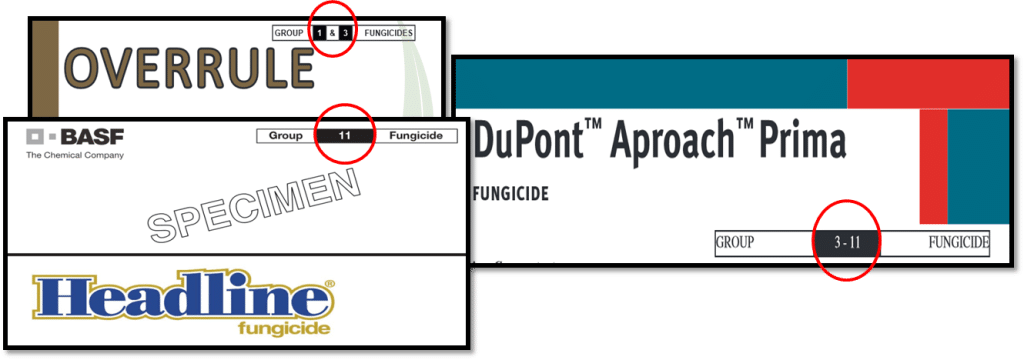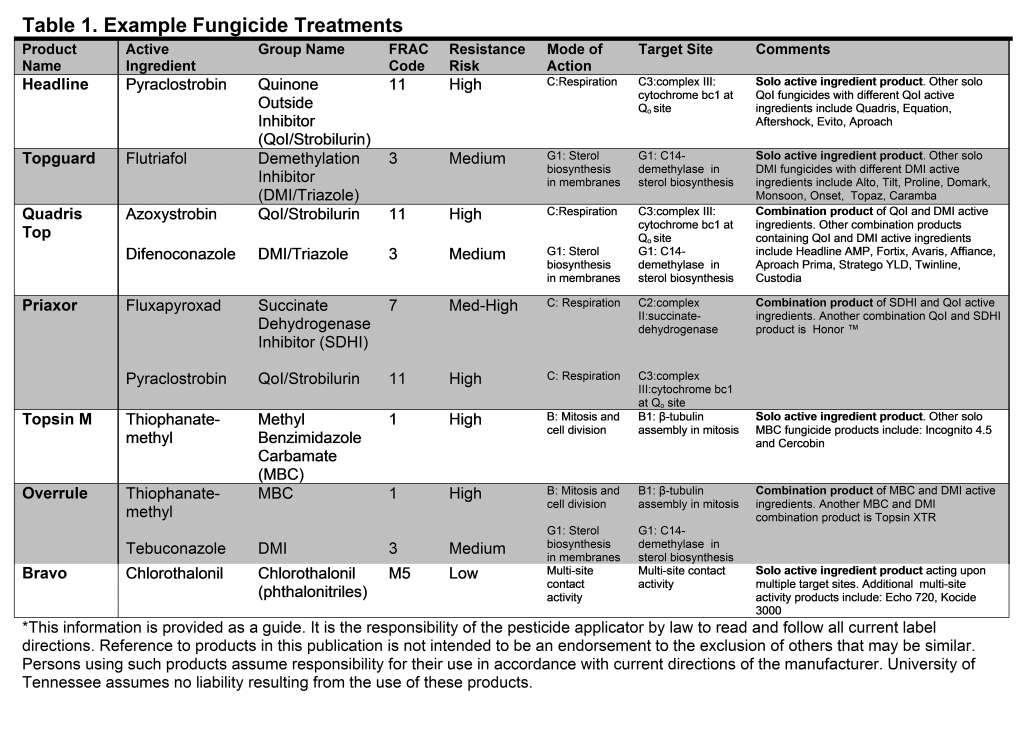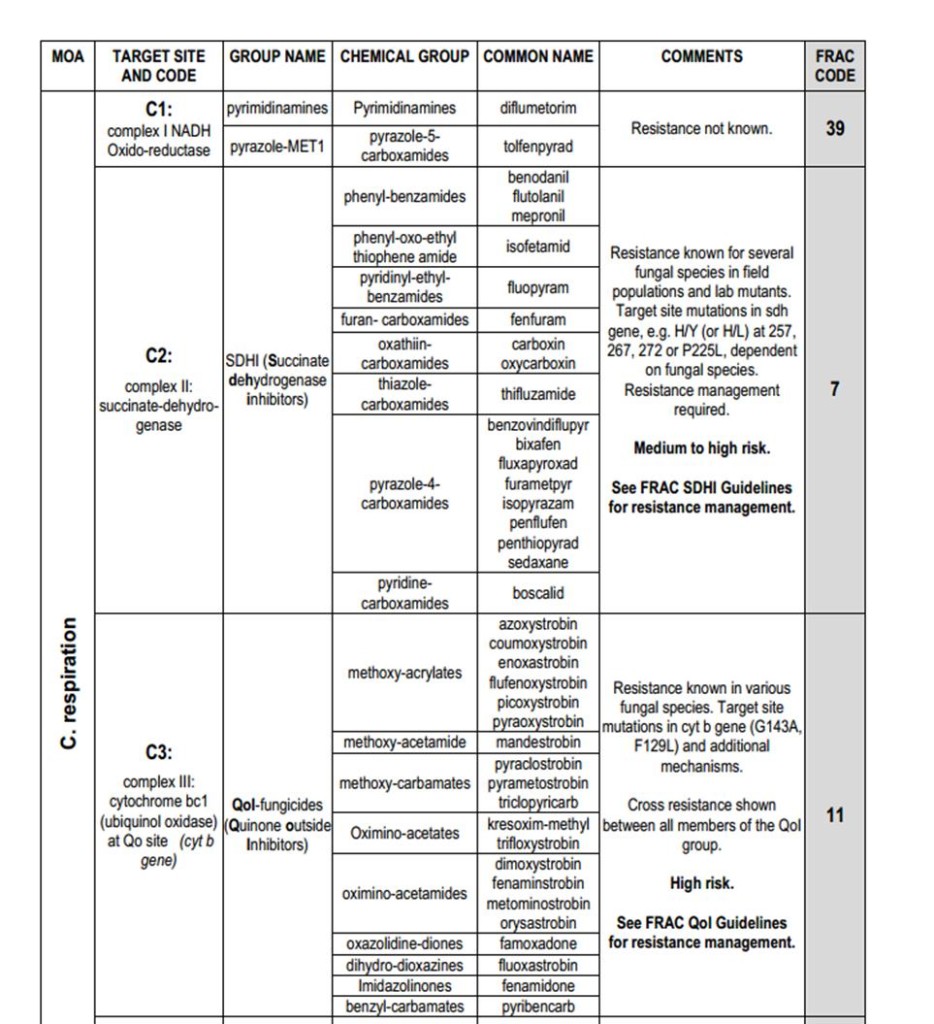Fungicide resistance is a very real concern in field crops in Tennessee and as fungicide resistance continues to be reported, it becomes equally important to be aware of the FRAC code(s) of the fungicide being applied. When a fungal plant pathogen becomes resistant to a specific fungicide, then the pathogen is either less or completely insensitive to fungicides in that FRAC group. The FRAC group or code can usually be found in the upper corner of a fungicide label (see the encircled numbers in the fungicide labels below).

The FRAC code is a number and/or letter combination assigned by the fungicide resistance action committee (FRAC) to group together active ingredients which demonstrate potential for cross resistance. Fungicides with the same FRAC code are at risk for cross resistance because they have the same target site. The target site and mode of action of a pesticide are sometimes incorrectly used interchangeably. Mode of action refers to the biochemical pathway being targeted within the pathogen. The target site is the specific process and/or enzyme which the fungicide active ingredient is interfering with. Fungicides may have the same mode of action but different target sites which results in a different FRAC code. For example (Table 2), QoI/Strobilurin fungicides and SDHI fungicides both inhibit fungal respiration, but they target a different part of the respiratory system.
To determine fungicide resistance risk (Low, Medium, or High) not only is the FRAC group of the chemical compound taken into account, but also how it interacts within the pathogen, and how the pathogen responds. Some pathogen-fungicide combinations demonstrate higher risk of resistance than others. There are many pathogens that have become resistant to fungicides. A fungicide application may have no effect at preventing or inhibiting fungal growth (disease development) in a field where the pathogen population is predominantly resistant to that fungicide. Proper fungicide use will help prolong the effectiveness of these fungicides against other still-sensitive pathogens.
To receive the maximum benefits from a fungicide application, it is best to apply fungicides according to label recommendations and only when the pathogen pressure is high enough to warrant treatment. Repeated uses of a fungicide with a single FRAC code are not typically recommended. If disease severity continues to increase after fungicide application, it may be possible that the pathogen is resistant to fungicides with that FRAC code, and continued applications of that fungicide would be ineffective. For example, there have been instances where frogeye leaf spot disease continues to progress in soybean after an application of a solo QoI/Strobilurin (FRAC code 11) product. Samples from such fields have confirmed that the population is dominated by QoI/Strobilurin resistant isolates of the pathogen. In such situations a DMI/Triazole (FRAC code 3), MBC (FRAC code 1), or a combination product would be a more effective choice to manage frogeye leaf spot.
Fungicide mixtures that combine two or more FRAC codes provide additional security that one of the active ingredients will kill the pathogen even if it is resistant to the other active ingredient in the mixture. This reduces the ability of fungicide-resistant pathogens to reproduce and populate the field, thus maintaining efficacy. However, if the pathogen is already resistant to one component of a fungicide mixture, using a fungicide mixture may eventually select for resistance to the other component. Be aware that chemical treatments are not the only disease management option. Planting resistant varieties is the first line of defense against many pathogens, and crop rotation may also help reduce disease.
Table 1 lists some of the most commonly used foliar fungicides available on the market for field crops in Tennessee, by trade name, active ingredient, chemical group name, FRAC code, resistance risk, mode of action, and target site. Further information on fungicide efficacy of these products on different diseases can be found at UTcrops.com, under Soybean, Diseases & Nematodes, the ‘ Fungicide Table – 2014.’
For additional, more detailed information on the fungicide resistance action committee and current FRAC codes visit: http://www.frac.info/

Table 2: Excerpt from the FRAC Code List 2014: Fungicides sorted by mode of action document. Entire document found here.


